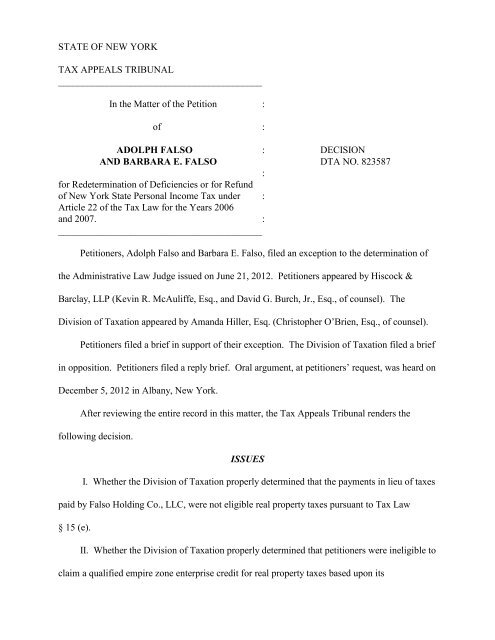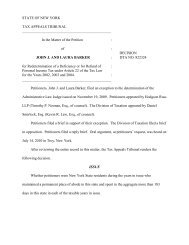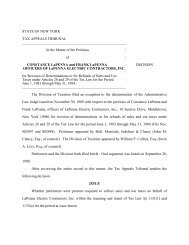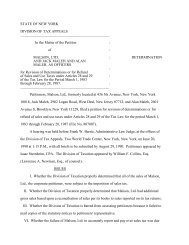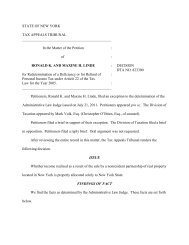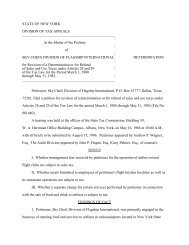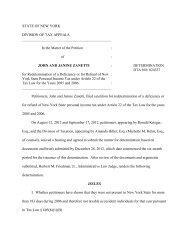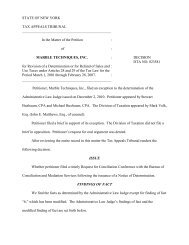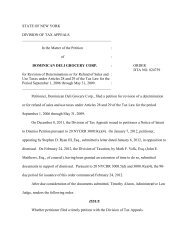Adolph and Barbara E. Falso - Tax Appeals Tribunal
Adolph and Barbara E. Falso - Tax Appeals Tribunal
Adolph and Barbara E. Falso - Tax Appeals Tribunal
You also want an ePaper? Increase the reach of your titles
YUMPU automatically turns print PDFs into web optimized ePapers that Google loves.
STATE OF NEW YORK<br />
TAX APPEALS TRIBUNAL<br />
__________________________________________<br />
In the Matter of the Petition :<br />
of :<br />
ADOLPH FALSO : DECISION<br />
AND BARBARA E. FALSO DTA NO. 823587<br />
:<br />
for Redetermination of Deficiencies or for Refund<br />
of New York State Personal Income <strong>Tax</strong> under :<br />
Article 22 of the <strong>Tax</strong> Law for the Years 2006<br />
<strong>and</strong> 2007. :<br />
__________________________________________<br />
Petitioners, <strong>Adolph</strong> <strong>Falso</strong> <strong>and</strong> <strong>Barbara</strong> E. <strong>Falso</strong>, filed an exception to the determination of<br />
the Administrative Law Judge issued on June 21, 2012. Petitioners appeared by Hiscock &<br />
Barclay, LLP (Kevin R. McAuliffe, Esq., <strong>and</strong> David G. Burch, Jr., Esq., of counsel). The<br />
Division of <strong>Tax</strong>ation appeared by Am<strong>and</strong>a Hiller, Esq. (Christopher O’Brien, Esq., of counsel).<br />
Petitioners filed a brief in support of their exception. The Division of <strong>Tax</strong>ation filed a brief<br />
in opposition. Petitioners filed a reply brief. Oral argument, at petitioners’ request, was heard on<br />
December 5, 2012 in Albany, New York.<br />
After reviewing the entire record in this matter, the <strong>Tax</strong> <strong>Appeals</strong> <strong>Tribunal</strong> renders the<br />
following decision.<br />
ISSUES<br />
I. Whether the Division of <strong>Tax</strong>ation properly determined that the payments in lieu of taxes<br />
paid by <strong>Falso</strong> Holding Co., LLC, were not eligible real property taxes pursuant to <strong>Tax</strong> Law<br />
§ 15 (e).<br />
II. Whether the Division of <strong>Tax</strong>ation properly determined that petitioners were ineligible to<br />
claim a qualified empire zone enterprise credit for real property taxes based upon its
-2-<br />
determination that Seneca Data Distributors, Inc., did not have a valid business purpose <strong>and</strong> was<br />
formed solely to gain empire zone tax benefits.<br />
FINDINGS OF FACT<br />
We find the facts as determined by the Administrative Law Judge except for finding of fact<br />
“2,” which has been substantially incorporated into finding of fact “1.” We have modified<br />
findings of fact “1,” “4” through “8,” <strong>and</strong> “12.” We have also made additional findings of fact.<br />
The Administrative Law Judge’s findings of fact, the modified findings of fact, <strong>and</strong> the<br />
additional findings of fact are set forth below.<br />
as follows:<br />
We modify finding of fact “1” of the Administrative Law Judge’s determination to read<br />
1<br />
Seneca Data Distributors, Inc. (Seneca Data 1) was a New York corporation that<br />
2 3<br />
was formed on November 7, 1980. SDD Holding, Inc. (Seneca Data 2) is a New<br />
York S corporation, formed on July 10, 2002 with a sole shareholder, <strong>Adolph</strong><br />
<strong>Falso</strong>. All income attributes of Seneca Data 2 flow through the S corporation to<br />
Mr. <strong>Falso</strong>’s personal income tax returns. Seneca Data 2 was certified eligible to<br />
receive qualified empire zone enterprise (QEZE) benefits prior to August 1, 2002.<br />
By way of a reorganization, effective October 1, 2002, Seneca Data 1 merged into<br />
4, 5<br />
Seneca Data 2.<br />
1<br />
The Administrative Law Judge determination referred to this entity as “Predecessor Corporation.” For<br />
purposes of this decision, the entity shall be referred to as “Seneca Data 1.”<br />
Inc.<br />
2<br />
This is noted in the Plan of Agreement of Merger of Seneca Data Distributors, Inc. into SDD Holdings,<br />
3<br />
The exhibits in the record indicate that the company formed on July 10, 2002 was legally named “SDD<br />
Holdings, Inc.” However, this company soon thereafter changed its legal name to “Seneca Data Distributors, Inc.”<br />
(the exact same former legal name of Seneca Data 1) on October 1, 2002. The Administrative Law Judge<br />
determination referred to this entity as “Seneca Data.” For purposes of this decision, the entity shall be referred to as<br />
“Seneca Data 2.”<br />
4<br />
The Certificate of Merger filed with the New York State Department of State indicates that the effective<br />
date of the merger was to be October 1, 2002.<br />
5<br />
We modify this fact to more accurately reflect the record.
-3-<br />
Seneca Data 1’s primary focus through the late 1990s was the distribution of computer<br />
products manufactured by other companies such as Okidata <strong>and</strong> Acer America.<br />
as follows:<br />
as follows:<br />
as follows:<br />
We modify finding of fact “4” of the Administrative Law Judge’s determination to read<br />
The management team of Seneca Data 1 consisted of: Kevin Conley, president;<br />
petitioner, <strong>Adolph</strong> <strong>Falso</strong>, owner; Jon Verbeck, chief financial officer; Brian<br />
Garrett, vice president of sales <strong>and</strong> marketing; <strong>and</strong> Doug Phillips, vice president<br />
of service. This management team remained in place upon the creation of Seneca<br />
Data 2. As reflected in the Plan of Merger Agreement, Seneca Data 2 had the<br />
exact same corporate directors as Seneca Data 1. 6<br />
We modify finding of fact “5” of the Administrative Law Judge’s determination to read<br />
Mr. Conley prepared a memor<strong>and</strong>um for the management team, dated August 31,<br />
1998 that identified various aspects of the operations of Seneca Data 1. The<br />
memo noted that Seneca Data 1’s sales <strong>and</strong> gross profits had increased from 1997<br />
to 1998 but that if expenses increased at a similar rate as they had in the past, the<br />
company would experience certain reduced profit margins in the future. The<br />
memo also noted that certain products sold by Seneca Data 1 had lower profit<br />
margins than other products Seneca Data 1 sold. Along with certain other<br />
recommendations, the memo noted that if the company was looking to change its<br />
business model, it should focus on increasing the sales of the more profitable<br />
products it was already selling, while attempting to reduce the expenses associated<br />
with the sale of its less profitable products. There is no reference in the memo to<br />
the creation of either a new corporate entity, or a change from being a distributor<br />
to being a manufacturer. When drafting his memor<strong>and</strong>um, Mr. Conley had not<br />
heard of the Empire Zones program. While Mr. Conley <strong>and</strong> the rest of the<br />
management team discussed the issues <strong>and</strong> recommendations set forth in the<br />
memor<strong>and</strong>um, no action was taken at that time. 7<br />
We modify finding of fact “6” of the Administrative Law Judge’s determination to read<br />
6<br />
We modify this fact to more accurately reflect the record.<br />
7<br />
We modify this fact to more accurately reflect the record.
as follows:<br />
as follows:<br />
-4-<br />
Petitioners submitted certain documentation addressing the merger of Seneca Data<br />
1 into Seneca Data 2. Namely, petitioners submitted the relevant Merger<br />
Agreement for Seneca Data 1 <strong>and</strong> Seneca Data 2, the new corporate bylaws, <strong>and</strong><br />
corporate financial statements for the year of, <strong>and</strong> those following, the<br />
reorganization. 8<br />
We modify finding of fact “7” of the Administrative Law Judge’s determination to read<br />
Seneca Data 1 entered into a “Payment in Lieu of <strong>Tax</strong> Agreement” (PILOT<br />
9<br />
Agreement), dated September 1, 1999, with the Onondaga County Industrial<br />
10<br />
Development Agency (Onondaga IDA), which agreement governed the<br />
payments in lieu of real property taxes that would otherwise have been assessed<br />
against the corporation’s real property on Round Pond Road (the Property). The<br />
express terms of the PILOT Agreement specify that it can be amended. 11<br />
We modify finding of fact “8” of the Administrative Law Judge’s determination to read<br />
On October 1, 2002, Seneca Data 1, Seneca Data 2 <strong>and</strong> <strong>Falso</strong> Holding Company,<br />
LLC (<strong>Falso</strong> Holding) entered into an agreement titled “Reaffirmation Agreement.”<br />
Among other items, this agreement confirmed the previous transfer of the<br />
12<br />
obligation to pay all real property taxes, <strong>and</strong> other certain obligations, from<br />
Seneca Data 1 to <strong>Falso</strong> Holding. The Reaffirmation Agreement also confirmed<br />
13<br />
that the PILOT Agreement was assigned from Seneca Data 1 to <strong>Falso</strong> Holding.<br />
8<br />
We modify this fact to more accurately reflect the record.<br />
9<br />
The Administrative Law Judge determination referred to this agreement as the “Round Pond Road<br />
PILOT” or the “PILOT agreement.” For purposes of this decision, the agreement shall be referred to as “PILOT<br />
Agreement."<br />
10<br />
The Administrative Law Judge determination referred to this entity as the “IDA.” For purposes of this<br />
decision, the entity shall be referred to as “Onondaga IDA.”<br />
11<br />
We modify this fact to more accurately reflect the record.<br />
12<br />
The Reaffirmation Agreement specified that the transfer of obligations to pay all real property taxes from<br />
Seneca Data 1 to <strong>Falso</strong> Holding was initially performed via an Amendment to Lease Agreement. A copy of the<br />
subject Amendment to Lease Agreement was included as an incorporated exhibit attached to the Reaffirmation<br />
Agreement.<br />
13<br />
The Reaffirmation Agreement specified that the transfer of obligations under the relevant PILOT<br />
Agreement from Seneca Data 1 to <strong>Falso</strong> Holding was initially performed via an Assignment <strong>and</strong> Assumption of<br />
Payment in Lieu of <strong>Tax</strong> Agreement between Seneca Data 1 <strong>and</strong> <strong>Falso</strong> Holding. A copy of the subject Assignment<br />
<strong>and</strong> Assumption of Payment in Lieu of <strong>Tax</strong> Agreement was included as an incorporated exhibit attached to the
-5-<br />
On the signatory page, under the heading “ACCEPTED AND CONSENTED:,” a<br />
representative of the Onondaga IDA executed the Reaffirmation Agreement. The<br />
Reaffirmation Agreement was also executed by Seneca Data 1, Seneca Data 2 <strong>and</strong><br />
<strong>Falso</strong> Holding. 14<br />
The Division of <strong>Tax</strong>ation (Division) conducted a desk audit of Seneca Data 2 <strong>and</strong> an<br />
audit of the personal income tax returns of petitioners, pursuant to which the Division determined<br />
that Seneca Data 2 was not formed for a valid business purpose pursuant to <strong>Tax</strong> Law § 14 (j) <strong>and</strong><br />
issued Notices of Deficiency L-033002753 <strong>and</strong> L-033002752, dated January 14, 2010, to<br />
petitioners for the years 2006 <strong>and</strong> 2007, respectively.<br />
The Division’s auditor assigned to this case reviewed Seneca Data 2's tax returns for the<br />
years 2002 through 2007, as well as the tax return for the tax year ending September 30, 2002,<br />
for the Seneca Data 1. The auditor requested several documents, such as internal memor<strong>and</strong>a, e-<br />
mails or written correspondence that could show why the reorganization was undertaken.<br />
Although petitioners asserted that a meeting of the board of directors was held to consider a<br />
merger, no meeting minutes were produced. The auditor asserted that petitioners had failed to<br />
provide sufficient proof that the reorganization was performed for valid business purposes. The<br />
auditor also concluded that Seneca Data 2 was formed to maximize tax incentives <strong>and</strong>, as such,<br />
was not formed for a valid business purpose. Accordingly, the auditor issued the Notices of<br />
Deficiency to petitioners reflecting those conclusions.<br />
In addition to Empire Zone benefits claimed through Seneca Data 2, Mr. <strong>Falso</strong> also<br />
claimed Empire Zone benefits, including the real property tax credit, through another certified<br />
Empire Zone enterprise, <strong>Falso</strong> Holding.<br />
Reaffirmation Agreement.<br />
14<br />
We modify this fact to more accurately reflect the record.
as follows:<br />
-6-<br />
We modify finding of fact “12” of the Administrative Law Judge’s determination to read<br />
The amount of the real property tax credit claimed by petitioners on their<br />
2006 <strong>and</strong> 2007 income tax returns was included as part of the sums sought in the<br />
Notices of Deficiency sent to petitioners for those tax years. The Division<br />
concluded that since <strong>Falso</strong> Holding was not a party to the written agreement with<br />
the Onondaga IDA, as is required by <strong>Tax</strong> Law § 15, <strong>Falso</strong> Holding was not<br />
eligible to claim the real property tax credit. The Division did not inform<br />
petitioners of its basis for this portion of the deficiency until approximately one<br />
week before the hearing. 15<br />
We also make the following additional findings of fact:<br />
Seneca Data 2' s audited Financial Statements for 2002 <strong>and</strong> 2003, <strong>and</strong> the related<br />
16<br />
Independent Auditor’s Report prepared by Fust Charles Chambers, LLP, specifically<br />
addressed the 2002 reorganization by stating in the notes to the Financial Statements, in relevant<br />
part:<br />
“Effective October 1, 2002, [Seneca Data 1] merged into [Seneca Data 2].<br />
[Seneca Data 2] was wholly owned by [Seneca Data 1's] sole stockholder.<br />
Accordingly, the transaction has been accounted for at book value <strong>and</strong> has been<br />
presented in the accompanying financial statements as if the pooling of interests<br />
method had been used.<br />
Concurrent with the merger, [Seneca Data 2], the surviving entity, changed its<br />
name to [Seneca Data 1's legal name]. Also, concurrent with the merger, treasury<br />
stock previously held by [Seneca Data 1] was retired, The par value of [Seneca<br />
Data 2] is $.01 per common share. The no par value common stock of [Seneca<br />
Data 1] was retired.”<br />
The relevant New York S Corporation Franchise <strong>Tax</strong> Return (form CT-3-S) filed by<br />
Seneca Data 2 included a statement made pursuant to Treas Reg § 1.368-3 (a) (1) that articulated<br />
the purposes for the relevant 2002 reorganization as follows:<br />
“The purpose [sic] of the reorganization were to: (1) reorganize the corporate<br />
structure by forming a new corporation governed by New York law, in order to<br />
benefit from the flexibility, predictability, <strong>and</strong> other legal advantages available<br />
under New York law; <strong>and</strong> (2) enable the corporation to maximize economic<br />
15<br />
We modify this fact to more accurately reflect the record.<br />
16<br />
The financial statements <strong>and</strong> related notes thereto were appropriately prepared by <strong>and</strong> are the<br />
responsibility of Seneca Data 2's corporate management.
-7-<br />
development incentives <strong>and</strong> benefits under state law. Both of these reasons are of<br />
substantial economic <strong>and</strong> business value to the corporation <strong>and</strong> its shareholder.”<br />
THE DETERMINATION OF THE ADMINISTRATIVE LAW JUDGE<br />
The Administrative Law Judge reviewed the applicable provisions of the Economic<br />
Development Zone Program including the 2002 amendments to <strong>Tax</strong> Law § 15. The<br />
Administrative Law Judge noted the respective parties’ obligations under the PILOT Agreement,<br />
<strong>and</strong> concluded that the Onondaga IDA was not a party to the Reaffirmation Agreement. As such,<br />
the Administrative Law Judge determined that petitioners were precluded from receiving certain<br />
credits at issue.<br />
Next, the Administrative Law Judge analyzed application of the “valid business purpose”<br />
test set forth in <strong>Tax</strong> Law § 14 (former [j] [4] [B]) <strong>and</strong> concluded that petitioners failed to meet<br />
their burden of proof establishing that the reorganization of Seneca Data 1 into Seneca Data 2<br />
was accomplished for a valid business purpose <strong>and</strong> not merely to gain tax incentives.<br />
Accordingly, the Administrative Law Judge upheld the Notices of Deficiency.<br />
ARGUMENTS ON EXCEPTION<br />
On exception, petitioners argue that they should be eligible to receive certain credits at<br />
issue, because there is a sufficient written arrangement between the Onondaga IDA <strong>and</strong> <strong>Falso</strong><br />
Holding. Petitioners also assert that Seneca Data 1 <strong>and</strong> Seneca Data 2 are significantly different<br />
entities <strong>and</strong>, therefore, the “valid business purpose” test does not apply to the required analysis.<br />
In the alternative, petitioners argue that if the “valid business purpose” test does apply, then the<br />
August 31, 1998 memo combined with petitioners’ witnesses’ testimony, establish that Seneca<br />
Data 2 was in fact formed for a valid business purpose, aside from maximizing tax benefits.
-8-<br />
In response to petitioners’ argument that they should be eligible to receive certain credits<br />
at issue, the Division argues that there was no written agreement between the Onondaga IDA <strong>and</strong><br />
<strong>Falso</strong> Holding, as required by the relevant law. With regard to application of the “valid business<br />
purpose” test, the Division argues that petitioners failed to provide any contemporaneous<br />
documentation pertaining to the reorganization of Seneca Data 1 into Seneca Data 2. Therefore,<br />
the Division argues that petitioners have failed to establish that Seneca Data 2 was established<br />
for a “valid business purpose” <strong>and</strong> seeks to have the Notices of Deficiency upheld.<br />
OPINION<br />
In 1986, the Legislature passed the Economic Development Zone Program, established<br />
under Article 18-B of the General Municipal Law. This program sought to improve economic<br />
conditions in impoverished areas of New York by stimulating private investment, business<br />
development <strong>and</strong> job creation (see General Municipal Law § 956).<br />
Under Article 18-B, certain business taxpayers can be certified as QEZEs (see General<br />
Municipal Law § 958; <strong>Tax</strong> Law § 14 [a]). A taxpayer must meet certain qualifications to be<br />
certified as a QEZE, including an employment test (see <strong>Tax</strong> Law § 14 [a]). For businesses<br />
certified as QEZEs prior to April 1, 2005, as is the case here, this test compares the employment<br />
number of a qualified business in its base period against its employment number in the years<br />
being tested (<strong>Tax</strong> Law § 14 [b] [1]). QEZE status provides eligibility for certain tax preferences<br />
in the form of credits <strong>and</strong> exemptions. These benefits include a credit for eligible real property<br />
taxes set against personal income tax under Article 22 (<strong>Tax</strong> Law § 15 [a]; 16 [a]).<br />
<strong>Tax</strong> Law § 15 (e), as first enacted, defined “eligible real property taxes” to mean “taxes<br />
imposed on real property which is owned by the taxpayer <strong>and</strong> located in economic development
-9-<br />
zones with respect to which the taxpayer is certified pursuant to article eighteen-B of the general<br />
municipal law for the taxable year” (see L 2000, ch 63, effective May 15, 2000).<br />
In 2002, <strong>Tax</strong> Law § 15 (e) <strong>and</strong> its definition of “eligible real property taxes” was<br />
amended. Specifically, the term “taxpayer” therein was changed to “QEZE,” <strong>and</strong> a requirement<br />
was added that the taxes become a lien on the real property during a taxable year in which the<br />
owner of the real property is both certified pursuant to article eighteen-B of the general municipal<br />
law <strong>and</strong> a qualified empire zone enterprise. In addition, the definition of the payments that<br />
comprised “eligible real property taxes” for purposes of the credit was exp<strong>and</strong>ed as follows:<br />
“In addition, the term ‘eligible real property taxes’ includes payments in lieu of<br />
taxes made by the QEZE to the state, a municipal corporation or a public benefit<br />
corporation pursuant to a written agreement entered into between the QEZE <strong>and</strong><br />
the state, municipal corporation, or public benefit corporation.”<br />
By this amendment to <strong>Tax</strong> Law § 15 (e), the Legislature recognized that PILOT payments<br />
made by a QEZE pursuant to a written agreement, constituted “eligible real property taxes” (see<br />
L 2002, ch 85, effective May 29, 2000).<br />
In this case, the parties to the original PILOT Agreement, dated September 1, 1999, were<br />
the Onondaga IDA <strong>and</strong> Seneca Data 1. Subsequently, on or about October 1, 2002, Seneca Data<br />
1, Seneca Data 2 <strong>and</strong> <strong>Falso</strong> Holding entered into the Reaffirmation Agreement, which confirmed,<br />
among other things, the assignment <strong>and</strong> transfer of the obligation to pay all real property taxes<br />
from Seneca Data 1 to <strong>Falso</strong> Holding. The Reaffirmation Agreement also confirmed that all the<br />
obligations <strong>and</strong> duties under the relevant PILOT Agreement were assigned by Seneca Data 1 to<br />
<strong>Falso</strong> Holding.<br />
In reviewing the terms of the PILOT Agreement, executed by the Onondaga IDA <strong>and</strong><br />
Seneca Data 1, it is clear that under the terms of that agreement, only Seneca Data 1 is obligated
-10-<br />
to make the PILOT payments. <strong>Falso</strong> Holding’s obligation to make the PILOT payments arises<br />
under a separate Assignment <strong>and</strong> Assumption of Payment in Lieu of <strong>Tax</strong> Agreement <strong>and</strong> a<br />
separate Amendment to Lease Agreement, the general terms of which were confirmed in the<br />
body of the Reaffirmation Agreement. The Division’s argues that the Onondaga IDA was not a<br />
party to the Assignment <strong>and</strong> Assumption of Payment in Lieu of <strong>Tax</strong> Agreement, the Amendment<br />
to Lease Agreement, or the Reaffirmation Agreement. The Division asserts that this precludes<br />
17<br />
petitioners from potentially receiving credits at issue. We reject this argument. The Onondaga<br />
IDA executed the Reaffirmation Agreement on the signature page under the heading<br />
“ACCEPTED AND CONSENTED.” The Reaffirmation Agreement was also separately signed<br />
by Seneca Data 1, Seneca Data 2 <strong>and</strong> <strong>Falso</strong> Holding. The Reaffirmation Agreement, which predates<br />
the tax years petitioned, reiterated <strong>and</strong> confirmed the transfer of the duty to pay certain<br />
payment in lieu of tax obligations under the PILOT Agreement from Seneca Data 1 to <strong>Falso</strong><br />
Holding.<br />
We note that, in general, a party whose signature appears on a contract, the text of which<br />
contains nothing to indicate that it is a party to the contract, is not bound to the terms of the<br />
contract (New Amsterdam Cas. Co. v Mobinco Brokerage Co., Inc., 219 App Div 486 [1927]).<br />
However, New York recognizes exceptions to the general rule, <strong>and</strong> there are circumstances<br />
where a person signing a contact, but not mentioned in the body therein, is considered a party to<br />
the contract (id.). “This is considered to be an application of the rule which requires effect to be<br />
given to all parts of a written instrument, where that is possible” (Esselstyn v McDonald, 98 App<br />
17<br />
The Division’s argument in opposition to granting these particular credits, is that <strong>Falso</strong> Holding was not a<br />
party to a written agreement with the Onondaga IDA. During the hearing, the Division’s auditor testified that this<br />
was in fact the case (Hearing Transcript at pages 45-46). In the absence of a more detailed record, we limit our<br />
analysis to that sole argument with regard to such credits.
-11-<br />
Div 197 [1904]. In this case, not only did the Onondaga IDA sign the Reaffirmation Agreement,<br />
it did so under a heading indicating that it was “accepting <strong>and</strong> consenting” to all of the terms of<br />
the Reaffirmation Agreement. The circumstances in this case are much more compelling than<br />
those where an entity’s signature merely appears at the end of a contract with no reference as to<br />
why the party signed the agreement. The facts of this case sufficiently meet the requirement that<br />
the arrangement be made “pursuant to a written agreement entered into between the QEZE <strong>and</strong><br />
the state, municipal corporation, or public benefit corporation.”<br />
On exception, petitioners also argue that Seneca Data 2 substantially differs in operations<br />
from Seneca Data 1 <strong>and</strong>, therefore the transaction at issue is not subject to the “valid business<br />
purpose” requirements of Section 14 (j) (4) of the <strong>Tax</strong> Law. Petitioners assert, <strong>and</strong> the Division<br />
does not challenge, that under Section 14 of the <strong>Tax</strong> Law, an entity such as Seneca Data 2,<br />
certified prior to August 1, 2002, passes the “valid business purpose” test if it qualifies as a new<br />
business under Section 14 (j). <strong>Tax</strong> Law Section 14 (j) (1) provides:<br />
“New business. (1) A new business shall include any corporation, except a<br />
corporation which is substantially similar in operation <strong>and</strong> in ownership to a<br />
business entity (or entities) taxable, or previously taxable, under section one<br />
hundred eighty-three, one hundred eighty-four, one hundred eighty-five or one<br />
hundred eighty-six of article nine; article nine-A, article thirty-two or thirty-three<br />
of this chapter; article twenty-three of this chapter or which would have been<br />
subject to tax under such article twenty-three (as such article was in effect on<br />
January first, nineteen hundred eighty) or the income (or losses) of which is (or<br />
was) includable under article twenty-two of this chapter.”<br />
Petitioners assert that if Seneca Data 1 <strong>and</strong> Seneca Data 2 are found not to be<br />
substantially similar in operation, the provisions of <strong>Tax</strong> Law Section 14 (j) (4) (B) that require<br />
application of the valid business purpose test do not apply. The Division does not challenge this<br />
assertion, but rather claims that Seneca Data 1 <strong>and</strong> Seneca Data 2 are substantially similar, <strong>and</strong> as
-12-<br />
such, the valid business purpose test applies. Based upon the record, we conclude that petitioners<br />
have failed to meet their burden of proof establishing their assertion that Seneca Data 1 <strong>and</strong><br />
Seneca Data 2 were not substantially similar at the time of the reorganization.<br />
Petitioners claim that Seneca Data 1 <strong>and</strong> Seneca Data 2 are not substantially similar<br />
because Seneca Data 1 was a distributor of computer products manufactured by other companies,<br />
whereas Seneca Data 2 is a manufacturing business that makes <strong>and</strong> sells its own highlycustomized<br />
products. Relying on the testimony of petitioners’ witnesses, petitioners assert that<br />
“[t]here wasn’t a piece [of Seneca Data 1's operations] that was left out” of the changes<br />
implemented in the reorganization from Seneca Data 1 to Seneca Data 2. Petitioners’ witnesses<br />
assert that the significant change in operations included hiring new people into leadership<br />
positions, putting new people into sales <strong>and</strong> product support positions, implementing a new<br />
compensation plan, <strong>and</strong> creating new marketing materials. Petitioners explain that although the<br />
ownership between the two companies remained similar, the entities [Seneca Data 1 <strong>and</strong> Seneca<br />
Data 2] “were vastly different in operation.” Petitioners presented the testimony of the corporate<br />
manager, Mr. Kevin Conley, to demonstrate that Seneca Data 2 was substantially different from<br />
Seneca Data 1. However, Mr. Conley’s testimony regarding who was hired <strong>and</strong> when, along<br />
with other assertions, was general in nature <strong>and</strong> vague <strong>and</strong> did not articulate with sufficient<br />
18<br />
specifics exactly what had changed <strong>and</strong> when such changes were implemented. Mr. Conley<br />
stressed that Seneca Data 1 <strong>and</strong> Seneca Data 2 are so different because Seneca Data 1 was a<br />
distributor, whereas Seneca Data 2 is a manufacturer.<br />
18<br />
Furthermore, we note that many, if not most, of Mr. Conley’s assertions were not supported with<br />
documentary evidence. Although such is not always required, it can be very useful in accurately determining or<br />
verifying asserted facts.
-13-<br />
In this regard, we first note that Section 3, the “Effects of Merger” section, of the Merger<br />
Agreement recognizes that Seneca Data 2 would succeed to all of Seneca Data 1's liabilities <strong>and</strong><br />
19<br />
assets. The record is not clear regarding whether, immediately preceding the October 2002<br />
merger between the two entities, Seneca Data 2 had any assets or liabilities of its own to<br />
contribute to the merged entity. Such appears very unlikely, given the circumstances <strong>and</strong> record<br />
as presented. Accordingly, in essence, Seneca Data 2 was a carbon copy of assets <strong>and</strong> liabilities<br />
of Seneca Data 1.<br />
We also note that at virtually the exact same time that the operating entity, Seneca Data 1,<br />
merged into the new <strong>and</strong> “vastly different” entity, Seneca Data 2, Seneca Data 2 changed its<br />
name back to Seneca Data 1's previous legal name. Furthermore, based upon the fact that the<br />
directors <strong>and</strong> corporate officers of Seneca Data 1 <strong>and</strong> Seneca Data 2 remained the same<br />
following the reorganization, the reorganization does not appear to have materially impacted the<br />
management of the different companies or the operating entity’s appearance to third parties.<br />
Moreover, Seneca Data 2's audited Financial Statements for 2002 <strong>and</strong> 2003 specifically<br />
addressed the reorganization. However, we note that management’s comments on the<br />
reorganization do not seem to express any emphasis on the alleged material significance of the<br />
transaction.<br />
In addition, Seneca Data 2's Financial Statements for 2002 <strong>and</strong> 2003, 2004 <strong>and</strong> 2005, <strong>and</strong><br />
2006 <strong>and</strong> 2007 each state that Seneca Data 2's operations consisted of operations as “a wholesale<br />
distributor <strong>and</strong> service center for computer products.” There is no reference whatsoever to the<br />
presence of manufacturing, or other operations for those years. These financial statements do not<br />
19<br />
The attachments to Seneca Data 2's 2002 form CT-3-S, New York S Corporation Franchise <strong>Tax</strong> Return,<br />
confirms this fact.
-14-<br />
recognize any material change in operations from how Seneca Data 1 operated, or what business<br />
Seneca Data 1 conducted, compared to those of Seneca Data 2.<br />
Seneca Data 2's Financial Statements for 2008 <strong>and</strong> 2009 recognize that the sole<br />
shareholder of Seneca Data 2 became the primary owner of a new company, Revonate<br />
Manufacturing, LLC (Revonate), which was formed in February of 2008, for the purpose of<br />
manufacturing computer products. The Seneca Data 2 Financial Statements for 2008 <strong>and</strong> 2009<br />
20<br />
recognize that the companies’ operations now included those of “a computer manufacturer,<br />
distributor <strong>and</strong> a value added technology partner . . . .”<br />
Thus, even though petitioners assert that the 2002 reorganization materially changed the<br />
company’s business model from a distribution company to a manufacturing company, the<br />
relevant financial statements produced by Seneca Data 2's management, <strong>and</strong> audited by an<br />
independent accounting firm, do not recognize any such monumental changes at the time of the<br />
reorganization. The relevant financial statements do not recognize manufacturing as an<br />
important business component of Seneca Data 2's operations until 2008, approximately six years<br />
after the merger. The recognition of manufacturing as an important <strong>and</strong> substantial business<br />
component of Seneca Data 2's operations appears to have been the direct result of the acquisition<br />
21<br />
of a new company, Revonate, in 2008, rather than a result of the 2002 reorganization.<br />
Petitioners assert that, in addition to the testimony of a corporate manager, the 1998<br />
memor<strong>and</strong>um is proof of the proposition that Seneca Data 2 was substantially different from<br />
Seneca Data 1 <strong>and</strong> was created for a valid business purpose. First, we note that nowhere in the<br />
20<br />
Seneca Data 2's financial statements were presented consolidated with the operations of Revonate.<br />
21<br />
Petitioners’ counsel attempts to dilute the relevance <strong>and</strong> significance of the audited financial statements.<br />
We are not inclined to disregard audited financial statements as petitioners’ counsel desires us to do.
-15-<br />
1998 memor<strong>and</strong>um is the creation of Seneca Data 2 or a reorganization like the one carried out in<br />
2002 mentioned. Furthermore, the date of the 1998 memor<strong>and</strong>um (approximately four years<br />
before the merger) in light of its content, appears tenuously connected to the 2002 merger.<br />
Petitioners never adequately explained how the 2002 reorganization was a necessary or integral<br />
part of what was advanced by the 1998 memor<strong>and</strong>um. The 1998 memor<strong>and</strong>um is not a factual<br />
statement regarding how Seneca Data 2's operations differed from Seneca Data 1's operations.<br />
Rather, it is a proposal that certain changes in business operations should be considered in the<br />
future. Our analysis at this juncture is whether or not Seneca Data 2's operations were<br />
substantially similar to Seneca Data 1's operations.<br />
The 1998 memor<strong>and</strong>um <strong>and</strong> the testimony of the corporate manager do not outweigh the<br />
weight of the disclosures contained in the audited corporate financial statements <strong>and</strong> the<br />
disclosures made in the relevant tax returns, as discussed below, which do not indicate any<br />
immediate material changes between the entities.<br />
Petitioners fail to establish that significant changes between Seneca Data 1's <strong>and</strong> Seneca<br />
Data 2s operations occurred within a close time frame of the reorganization. There is no specific<br />
time frame prescribed by law to guide the analysis of whether a predecessor company is<br />
significantly different from a successor company. However, it seems appropriate, given the<br />
context of the relevant statute, that more material changes between Seneca Data 1 <strong>and</strong> Seneca<br />
Data 2 would have been clearly evident in a period of fewer than six years after a reorganization.<br />
We note that the relevant statute was written in the context of an immediate analysis of whether a<br />
valid business purpose existed for the transaction at the time of the transaction. Accordingly, it<br />
seems appropriate that the analysis of whether the predecessor <strong>and</strong> successor companies were<br />
substantially similar in operation likewise requires a more immediate analysis. Petitioners’
-16-<br />
argument, that the relevant legal analysis should compare the predecessor company to a successor<br />
company that has existed <strong>and</strong> been in business for several years after the relevant reorganization,<br />
appears misplaced.<br />
The gradual changes in Seneca Data 2's operations over the years (prior to the acquisition<br />
of Revonate in 2008) were not immediate or significant changes. Moreover, as discussed below,<br />
it appears that the 2002 merger transaction was performed solely to gain tax benefits <strong>and</strong> not to<br />
change the businesses’ underlying operations.<br />
Next, we address whether the 2002 reorganization that created Seneca Data 2 had a valid<br />
business purpose within the meaning <strong>and</strong> intent of <strong>Tax</strong> Law § 14. After the year 2000, the<br />
Legislature identified abuses of the Empire Zones program by a process known as “shirt<br />
changing,” whereby an existing business would reorganize into a new entity to qualify for, or<br />
enhance, its QEZE benefits. The Legislature held this practice to be inconsistent with the intent<br />
of the program (General Municipal Law § 956), <strong>and</strong> sought to reform the legislation.<br />
Commencing with tax years beginning on or after January 1, 2005, chapter 161 of the<br />
Laws of 2005 amended <strong>Tax</strong> Law § 14 (b) (1) to provide that:<br />
“For entities first certified prior to August first, two thous<strong>and</strong> two, if the entity had<br />
a base period of zero years or zero employment in the base period, then the<br />
employment test will be met only if the enterprise qualifies as a new business<br />
under subdivision (j) of this section.”<br />
Based upon the record as presented, in order for Seneca Data 2 to receive certain benefits<br />
at issue, Seneca Date 2 must meet the new business “valid business purpose” test, which, as set<br />
forth in <strong>Tax</strong> Law § 14 (former [j] [4] [B]), provides that a corporation or partnership:<br />
“shall not be deemed a new business if it was not formed for a valid business<br />
purpose, as such term is defined in clause (D) of subparagraph one of paragraph<br />
(o) of subdivision nine of section two hundred eight of this chapter <strong>and</strong> was<br />
formed solely to gain empire zone benefits.”
-17-<br />
<strong>Tax</strong> Law § 208 (9) (o) (1) (D) defines “valid business purpose” as follows:<br />
“A valid business purpose is one or more business purposes, other than the<br />
avoidance or reduction of taxation, which alone or in combination constitute the<br />
primary motivation for some business activity or transaction, which activity or<br />
transaction changes in a meaningful way, apart from tax effects, the economic<br />
position of the taxpayer. The economic position of the taxpayer includes an<br />
increase in the market share of the taxpayer, or the entry by the taxpayer into new<br />
business markets.”<br />
Accordingly, in order to establish entitlement to the benefits <strong>and</strong> tax credits sought for the<br />
years at issue, obtaining QEZE benefits cannot have been the primary purpose for the 2002<br />
reorganization.<br />
noted that:<br />
In Matter of Graphite Metallizing Holdings (<strong>Tax</strong> <strong>Appeals</strong> <strong>Tribunal</strong>, July 7, 2011), we<br />
“At issue are QEZE real property tax credits, which are ‘a particularized species<br />
of exemption from taxation’ (Matter of Mallinckrodt, <strong>Tax</strong> <strong>Appeals</strong> <strong>Tribunal</strong>,<br />
November 12, 1992). As it is the party seeking the exemption, petitioner bears<br />
the burden of proving clear entitlement to this exemption (see Matter of Marriott<br />
Family Rests. v. <strong>Tax</strong> <strong>Appeals</strong> Trib., 174 AD2d 805 [1991], lv denied 78 NY2d<br />
863 [1991]) . . . .<br />
The inquiry into whether a valid business purpose existed at the time of<br />
action ‘involves a subjective analysis of the taxpayer’s intent’ (Winn-Dixie Stores<br />
v. Commissioner, 113 TC 254, 280 [1999], affirmed 254 F3d 1313 [2001], cert<br />
denied 535 US 986 [2002]; Gregory v. Helvering, 293 US 465 [1935]). We note<br />
that in cases addressing valid business purpose ‘the question for determination is<br />
whether what was done, apart from the tax motive, was the thing which the statute<br />
intended’ (Gregory v. Helvering, supra, at 469; citations omitted).”<br />
In reviewing the record for evidence that existed at the time of the reorganization, the<br />
Administrative Law Judge appropriately pointed to exhibit “L,” the initial New York S<br />
Corporation Franchise <strong>Tax</strong> Return (form CT-3-S) filed by Seneca Data 2. Attached to the return<br />
is a statement made pursuant to Treas Reg § 1.368-3 (a) (1) that describes the purposes of the<br />
relevant reorganization as follows:
-18-<br />
“The purpose [sic] of the reorganization were to: (1) reorganize the corporate<br />
structure by forming a new corporation governed by New York law, in order to<br />
benefit from the flexibility, predictability, <strong>and</strong> other legal advantages available<br />
under New York law; <strong>and</strong> (2) enable the corporation to maximize economic<br />
development incentives <strong>and</strong> benefits under state law. Both of these reasons are of<br />
substantial economic <strong>and</strong> business value to the corporation <strong>and</strong> its shareholder.” 22<br />
We find this statement telling. As the Administrative Law Judge recognized, the first<br />
claimed purpose, to reorganize as a New York State corporation to gain access to the benefits of<br />
being incorporated in New York was an illusory goal, given the fact that Seneca Data 1 was<br />
already a New York corporation. The only other asserted purpose for the relevant reorganization<br />
appears to be the attainment of QEZE benefits. Although we recognize that this alone may be a<br />
valid business purpose for a reorganization under New York’s business corporation law, such is<br />
not considered a sufficient valid business purpose to receive QEZE benefits under the relevant<br />
tax law. The other telling evidence prepared at a time close to the reorganization were the<br />
audited financial statements, which, as reviewed above, do not indicate that there was any<br />
significant business reason to the 2002 reorganization. On exception, petitioners still fail to<br />
convince us why the 2002 reorganization was necessary to accommodate their desire to focus on<br />
manufacturing.<br />
We also note that the auditor on this case requested several potentially relevant<br />
documents from petitioners, such as internal memor<strong>and</strong>a, e-mails <strong>and</strong> written correspondence<br />
that could show why the reorganization was undertaken. As the Administrative Law Judge<br />
noted, no meeting minutes or other additional requested documentation was produced. Although<br />
such is not necessarily determinative of the matter, petitioners failure to produce any further<br />
relevant contemporaneously prepared business records supporting their position (although<br />
22<br />
It appears as though the original statement filed with Seneca Data 2's federal tax return was signed under<br />
penalties of perjury by the corporate chief financial officer.
-19-<br />
requested to do so) further buttresses our conclusion that petitioners have failed to establish an<br />
appropriate business purpose for the 2002 reorganization.<br />
At the hearing, petitioners offered the testimony of Mr. Kevin Conley to demonstrate a<br />
valid business purpose for the reorganization. His testimony addressed the issue regarding<br />
changes made to the company in the years following the merger. For instance, Mr. Conley<br />
explained that their business model was not sustainable <strong>and</strong> that certain changes needed to be<br />
made. However, we agree with the Administrative Law Judge that Mr. Conley’s general<br />
explanations did not rise to the level of sufficient proof required to find that the reorganization<br />
was accomplished for a valid business purpose. There was never an explanation as to why the<br />
reorganization was required in order to accomplish any of the goals set for the company.<br />
Companies can <strong>and</strong> often do make the changes Mr. Conley addressed, without reorganizing into<br />
a new entity. Moreover, as Seneca Data’s financial statements <strong>and</strong> other evidence indicates, for<br />
several years following the reorganization, the “new” entity appears to have been virtually a copy<br />
of the earlier entity. We need not restate our analysis above or that performed by the<br />
Administrative Law Judge in this regard. We agree with the Administrative Law Judge that<br />
petitioners failed to sustain their burden of proof that the reorganization was accomplished for a<br />
valid business purpose <strong>and</strong> not merely to gain tax incentives.<br />
Accordingly, it is ORDERED, ADJUDGED <strong>and</strong> DECREED that:<br />
1. The exception of <strong>Adolph</strong> <strong>and</strong> <strong>Barbara</strong> E. <strong>Falso</strong> is granted to the extent that the real<br />
property tax credits for payments in lieu of taxes made pursuant to a written agreement with the<br />
Onondaga IDA, are granted, but in all other respects is denied;<br />
2. The determination of the Administrative Law Judge is reversed to the extent indicated<br />
in paragraph “1” above, but is otherwise affirmed;
-20-<br />
3. The petition of <strong>Adolph</strong> <strong>and</strong> <strong>Barbara</strong> E. <strong>Falso</strong> is granted to the extent indicated in<br />
paragraph “1” above, but is otherwise denied; <strong>and</strong><br />
4. The Notices of Deficiency, L-033002753 <strong>and</strong> L-033002752, dated January 14, 2010,<br />
as modified in accordance with paragraph “1” above, are sustained.<br />
DATED: Albany, New York<br />
May 23, 2013<br />
/s/ James H. Tully, Jr.<br />
James H. Tully, Jr.<br />
President<br />
/s/ Charles H. Nesbitt<br />
Charles H. Nesbitt<br />
Commissioner


